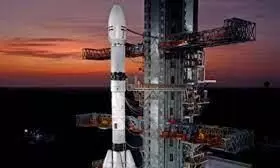
ISRO’s new weather satellite to boost Earth and ocean observations
text_fieldsBengaluru: ISRO marked another achievement with the successful launch of the next-generation weather observation satellite, INSAT-3DS, via a GSLV rocket.
The 2274 kg satellite aims to enhance the study of Earth's surfaces and oceanic observations, providing continuity of services for meteorological observations, disaster warnings, and satellite-aided Search and Rescue Services (SAR).
ISRO Chairman S Somanath expressed satisfaction with the flawless mission, describing the GSLV rocket technology as a "naughty boy" that has matured into an "obedient, disciplined boy." The success instills confidence for its deployment in future missions like the NASA-ISRO Synthetic Aperture Radar (NISAR) collaboration.
INSAT-3DS, a follow-on mission to its predecessors INSAT-3D and INSAT-3DR, was launched from Sriharikota, Andhra Pradesh.
The satellite's payload includes instruments for cloud properties, fog, rainfall, snow cover, fire, smoke, and various land and ocean observations. The improved radiometric performances of imager and sounder payloads aim to enhance data collection capabilities.
Mission Director Tomy Joseph commended the GSLV's evolution, likening it to the reliable Polar Satellite Launch Vehicle (PSLV). The successful launch bodes well for ISRO's upcoming GSLV-based missions, with NISAR being a prominent collaboration with NASA.
INSAT-3DS, injected into a favorable orbit, is set to undergo a series of maneuvers to reach its designated geostationary orbit in the coming days. The satellite's data is expected to benefit various Earth science departments, including the India Meteorological Department, National Centre for Medium Range Weather Forecasting, and others.
























